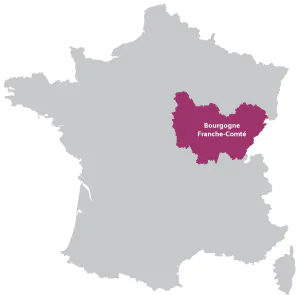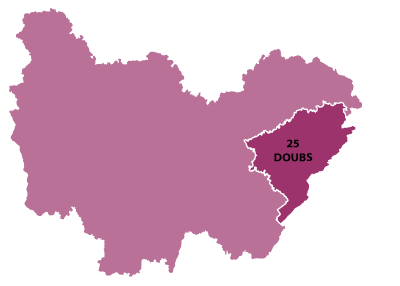Besançon, France

Looking towards the fortifications of Besançon from the River Doubs

Besançon is in the Bourgogne Franche-Comté region.

Besançon is in the (25) Doubs departement

Map of Besançon in the Doubs
About Besançon
Besançon is in the Doubs department of the Franche-comte region.
Besançon is the capital city of the Doubs department and the former capital city of the old region of Franche-Comté (Bourgogne-Franche-Comté as of 2016). It's a beautiful city located on a meander of the Doubs river.Surrounded by hills and almost encircled by the river Doubs, Besançon is not one of the most well known French cities despite being a beautiful and interesting location to visit in the Eastern part of the country just 60km from the Swiss border. Traditionally, the city is an important centre of horology which is part of Besançon's rich heritage an d a visit to the musuem of Time is very worthwhile.
Architecture and history aficionados can find everything they need in Besançon. Indeed, the city is more than two millennia old and filled with archaeological spots, historical monuments from the Middle Ages and modern period. In his Gallic Wars, Julius Caesar spoke of Vesontio, Besançon's ancient name, as the most important city of Sequani people and a heavily fortified stronghold thanks to its geographical location. The Sequani were the Gallic people who lived in the region. Later in the Middle Ages, Besançon was an independent city governed by an archbishop until it became a free imperial city governed by its citizens in 1290. Besançon was not yet in France but part of the Holy Roman Empire. In 1674, a 27 days long siege brought Besançon and the Franche-Comté into King Louis XIV's kingdom.
La Porte Noire (The Black Door) was built in 175 and is one the important monuments of the Gallo-Roman period, it is built with the local clear pink coloured stone as is most of the city. The door gives access to the beautiful cathedral of Saint Jean which dates from the 3rd century and will undergo various reconstructions with Romane, Gothique and Baroque styles.
La Porte Noire also gives you access up the very steep road to the imposing Citadelle which over looks the city was built by the military architect Vauban, the construction began in 1668 and the fortification became an important but very expensive element in the defense of France for King Louis XIV.
Besançon is the birth town of one of France's most famous personalities, the poet, novelist and play-writer Victor Hugo, born the 26th Feburary 1802. Across the road from his natal house were born Auguste & Louis Lumière, the "frères Lumière", famed for their inventions in photography and cinema.
Visitors can admire Besançon's unique architecture with its blue and grey building made of local limestone and its hundreds of monuments. The 18th-century fortifications and citadel defending the city were created by the famous military architect Vauban are listed on the UNESCO World Heritage Sites. There are also several museums such as the Beaux Arts, the Time Museum dedicated to horology, Victor Hugo's birthplace or the Second World War Resistance museum located at the citadel. The city can also boast about its important religious heritage. The historical centre on the meander has no less than two Roman Catholic churches and the Saint-Jean Cathedral, the seat of the archbishop that testifies of the city's religious importance. There is also a 19th-century Moorish-style Jewish Synagogue listed as a historical monument.
Besançon has been nominated as the “best French city to live” several times and to this day remains the “greenest French city” thanks to its many parks and the preservation of natural sites.
Cyclists and pedestrians are priority in the city centre, the trams lines and buses also help to easy the typical traffic problems of urban areas.





